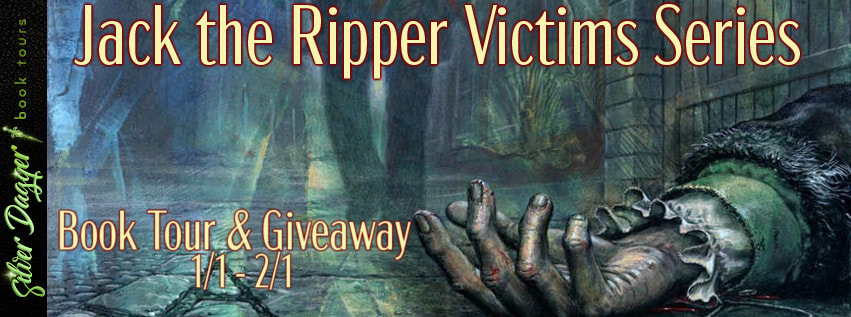
Alan M. Clark’s Jack the Ripper Victims Series is comprised of five novels, one for each of the canonical victims of the murderer. These stories are not only meant to appeal to those interested in the horror that was the Autumn of Terror, but also those interested in the struggles of women in the 19th century. They are well-researched, fictional dramatic stories meant to help readers walk in the shoes of the victims and give a sense of the world as each of the women may have experienced it. The timelines for the stories run mostly concurrently, so it doesn’t matter in what order the books in the series are read. They are simultaneously drama, mystery, thriller, historical fiction, and horror. They are novels concerning horror that happened.
A Brutal Chill in August The First Victim of Jack the Ripper by Alan M. Clark Genre: Crime Horror Publisher: IFD Publishing Publication Date: December 7, 2019 We all know about Jack the Ripper, the serial murderer who terrorized Whitechapel and confounded police in 1888, but how much do we really know about his victims? Pursued by one demon into the clutches of another, the ordinary life of Mary Ann “Polly” Nichols is made extraordinary by horrible, inhuman circumstance. Jack the Ripper’s first victim comes to life in this sensitive and intimate fictionalized portrait, from humble beginnings, to building a family with an abusive husband, her escape into poverty and the workhouse, alcoholism, and finally abandoned on the streets of London where the Whitechapel Murderer found her. With A Brutal Chill in August, Alan M. Clark gives readers an uncompromising and terrifying look at the nearly forgotten human story behind one of the most sensational crimes in history. This is horror that happened. Add to GoodreadsAmazon * Apple * Apple Audiobook * B&N * KoboMusic Video The song sung by the ghost that haunts Mary Ann “Polly” Nichols https://youtu.be/NQGvZ6arwv0
Apologies to the Cat’s Meat Man The Second Victim of Jack the Ripper Publication Date: June 9, 2017 This novel is part of the Jack the Ripper Victims Series. Each novel in the series is a stand-alone story. Annie Chapman led a hard, lower class life in filthy 19th century London. Late in life, circumstances and and her choices led her to earn her crust by solicitation. After a bruising brawl with another woman over money and a man, she lost her lodgings and found herself sleeping rough. That dangerous turn of events delivered her into the hands of London’s most notorious serial killer, Jack the Ripper. Contrasting her last week alive with the experiences of her earlier life, the author helps readers understand how she might have made the decisions that put her in the wrong place at the wrong time Add to GoodreadsAmazon * Apple * B&N * KoboBook Trailerhttps://youtu.be/oDKsC9KJ3RI
Say Anything But Your Prayers The Third Victim of Jack the Ripper Publication Date: June 11, 2017 This novel is part of the Jack the Ripper Victims Series. Each novel in the series is a stand-alone story. An imaginative reconstruction of the life of Elizabeth Stride, the third victim of Jack the Ripper. The beast of poverty and disease had stalked Elizabeth all her life, waiting for the right moment to take her down. To survive, she listened to the two extremes within herself–Bess, the innocent child of hope, and Liza, the cynical, hardbitten opportunist. While Bess paints rosy pictures of what lies ahead and Liza warns of dangers everywhere, the beast, in the guise of a man offering something better, circles ever closer. Add to GoodreadsAmazon * Apple * B&N * Kobo
Of Thimble and Threat The Fourth Victim of Jack the Ripper Publication Date: September 28, 2017 In Victorian London, the greatest city of the richest country in the world, the industrial revolution has created a world of decadence and prosperity, but also one of unimaginable squalor and suffering. Filth, decay, danger, sorrow, and death are ever-present in the streets. Catherine Eddowes is found murdered gruesomely in the city’s East End. When the police make their report, the only indicators of her life are the possessions carried on her person, likely everything she owned in the world. In Of Thimble and Threat, Alan M. Clark tells the heartbreaking story of Catherine Eddowes, the fourth victim of Jack the Ripper, explaining the origin and acquisition of the items found with her at the time of her death, chronicling her life from childhood to adulthood, motherhood, her descent into alcoholism, and finally her death. Of Thimble and Threat is a story of the intense love between a mother and a child, a story of poverty and loss, fierce independence, and unconquerable will. It is the devastating portrayal of a self-perpetuated descent into Hell, a lucid view into the darkest parts of the human heart. Add to GoodreadsAmazon * Apple * B&N * Kobo
The Prostitute’s Price The Fifth Victim of Jack the Ripper Publication Date: August 30, 2018 A novel that beats back our assumptions about the time of Jack the Ripper. Not the grim story of an unfortunate drunken prostitute killed before her time, but one of a young woman alive with all the emotional complexity of women today. Running from a man wanting her to pay for her crimes against his brother, Mary Jane Kelly must recover a valuable hidden necklace and sell it to gain the funds to leave London and start over elsewhere. Driven by powerful, if at times conflicting emotion, she runs the dystopian labyrinth of the East End, and tries to sneak past the deadly menace that bars her exit. Although THE PROSTITUTE’S PRICE is a standalone tale, and part of the Jack the Ripper Victims Series, it is also a companion story to the novel, THE ASSASSIN’S COIN, by John Linwood Grant. The gain a broader experience of each novel, read both. Add to GoodreadsAmazon * Apple * B&N * KoboBook Trailerhttps://youtu.be/9h3V9kVL2Ko
Author and illustrator, Alan M. Clark grew up in Tennessee in a house full of bones and old medical books. His awards include the World Fantasy Award and four Chesley Awards. He is the author of seventeen books, including twelve novels, a couple of novellas, four collections of fiction, some of them lavishly illustrated, and a nonfiction full-color book of his artwork. Mr. Clark’s company, IFD Publishing, has released 42 titles of various editions, including traditional books, both paperback and hardcover, audio books, and ebooks by such authors as F. Paul Wilson, Elizabeth Engstrom, and Jeremy Robert Johnson. Alan M. Clark and his wife, Melody, live in Oregon. www.alanmclark.com Visit his blog: https://ifdpublishing.com/blogWebsite * Blog * Facebook * Facebook * Instagram * Amazon * Goodreads

Excerpts from Say Anything but Your Prayers
Author’s Note—The Ripper’s London
This is a work of fiction inspired by the life of Elizabeth Stride, a woman believed to be the
third victim of Jack the Ripper. For purposes of storytelling, I have not adhered strictly to her
history. I have assigned to my main character emotional characteristics and reactions that seem
consistent with her life and circumstances. I’ve addressed puzzling events in Elizabeth Stride’s
life, and a mysterious confusion that occurred during the coroner’s inquest into her murder
concerning her identity.
To be clear, this novel is not about Jack the Ripper. The series itself is not about the killer.
Instead, each novel in the series explores the life of a different victim.
I wrote this note in the month of October, a time for scary fun. I truly enjoy the cute horror of
Halloween and a good, over-the-top zombie film, yet as one who has always been intrigued by
the dark and disturbing, as a practitioner in the horror genre, a professional writer for almost two
decades, and an illustrator for almost three, sometimes that sort of fun scare falls flat. My interest
has been drawn over time to the real horror of history and the lessons to be learned from it.
Long ago, when I first learned of Jack the Ripper and the murders associated with the killer, I
was, as most everyone is, intrigued by the endless speculation about who he might have been (I
use male pronouns when referring to him merely because of the name Jack; though we don’t
know the gender of the Whitechapel Murderer). The more I read about the murders and the
various theories, the less interested I was in the killer and the more intrigued I became with the
environment in which the murders took place. As I learned more about Victorian London and
Page 2 of
how rapidly it changed due to the industrial revolution, the more interesting I found the lives of
those who lived there at the time. Although I couldn’t learn much about the killer, I could gain
some knowledge of the five female victims. Potentially, there are more than five, but those
considered canonical victims are Mary Ann Nichols, Annie Chapman, Elizabeth Stride,
Catherine Eddowes, and Mary Jane Kelly.
Coroner’s inquests were held to determine the cause of death for each of the women. The
inquiries are essentially trials, with juries and witnesses to help make a determination about the
manner of a victim’s demise. The verdict in each of the five cases was “Wilful murder against
some person or persons unknown.”
The words, actions, movements, and motivations of each of the women are most clearly
known to history closest to the time of their deaths because of the testimony of the witnesses
called during the inquests. In some cases, such as that of Elizabeth Stride, the last couple of
hours were recounted in detail, and in other cases, such as that of Catherine Eddowes, we have a
good idea what she did within several days of her death. The farther we go into the past away
from the hour of their deaths, however, the less detailed and the more generalized is the
information about them. Within the few years prior to their deaths, all five had suffered real
hardship—all had engaged in prostitution to survive, most, if not all, had been active alcoholics,
and most had spent time in the dehumanizing workhouse system.
In Victorian England, the Industrial revolution had led to large-scale unemployment, much
the way the Tech Revolution has done in America today. Victorian London, much like large
American cities today, suffered from overcrowding and large numbers of homeless.
We can see a modern reflection of the victims of Jack the Ripper in the homeless of twenty-
first century America. Much of the cause of that homelessness went unseen in Victorian times, as
Page 3 of
it does now. With the rise in the numbers of the homeless, then as now, people had a tendency to
shy away from the problem.
My natural inclination is to avoid knowing why so many people are hungry and without
shelter. I want to look away, and I don’t want to look away. My experience is that many people
are just as ambivalent. Many of the homeless are intoxicated much of the time or begging for the
means to become intoxicated. I can easily become disgusted with the endless need of the addicts
among the homeless. I could justify my righteousness by blaming their lack of hygiene, and their
crimes of desperation. However, I am a sober alcoholic and expect myself to have compassion
for them, even when it doesn’t come naturally. There, but for providence, go I.
Although I avoid those who are clearly intoxicated, on occasion I’ve asked someone begging
on the street for their story. Most aren’t good at telling a story, perhaps because they are rarely
asked to tell one. Even so, from what they say, I always get the sense that they have had happier
times, that they have capabilities, and that they have aspirations involving their own personal
interests and those whom they love.
Worse than the surface irritation of having to deal with a person who might be slovenly, dirty,
inconvenient, or in-my-face is the emotional stress of considering the plight of an unfortunate
person. My immediate response is to want to look away. I speak of my experience to take
responsibility for my reactions, yet I’m not alone. We find it easy to scorn the beggars on the
streets and then project that disdain on all homeless people, further isolating them. As a result,
the down and out are less likely to find help when in danger. If they are seriously harmed or
killed, fewer people step forward to try to find out what happened. Those who prey upon the
homeless more easily get away with their crimes. The same was true for the down and out of
Victorian London.
Page 4 of
What events in the lives of the five Jack the Ripper victims led to their demise on the streets
of London? How much of the way they lived was a result of the choices they made? What was
beyond their control? Were they chosen at random by their killer, or did he choose them because
he knew that fewer people would step forward to find out what happened to them? We don’t
have good, solid answers to these questions.
My impression is that their choices had something to do with securing their wellbeing,
however, much of their existence was beyond their control. The environment of London itself
was a danger. Literally hundreds of thousands of Londoners were killed by the pollution in the
air, water, and food. New industries popped up everywhere to support the burgeoning population
and to exploit the cheap labor market. Small factories occupied converted tenements or houses
that once held families in residential neighborhoods. Sometimes, only a part of such a tenement
or house was occupied by industry while the rest still functioned as a residence for individuals or
families. With an increase in the use of chemistry, and with little knowledge of the damage many
chemicals inflicted upon the bodies of those exposed to them, industries, such as match making,
destroyed the lives of their workers and those living within close proximity to production. Those
who suffered often did so without knowing why until it was too late. Matchmaking is only one
example of the industrial poisoning of Londoners. Deadly chemicals were everywhere. They
were used in medicines and in prepared foods as preservatives. Madness abounded, if not as a
result of the emotional hardships of life, then from chemical damage to the brain.
A life of poverty in London was slowly killing all of the Ripper’s victims. Survival within
that environment is the story that intrigues me. Those are lives I can relate to because I see
parallels with life in my own time.
Page 5 of
Regardless of whether the Ripper’s victims had few opportunities to live better lives or were
responsible in large part for their predicaments, their legacy is pitiful and poignant. Not the cute
horror of Halloween perhaps or the over-the-top-turned-almost-cartoon horror of slasher and
zombie films, the stories of the five women are full of emotional content, conflict, and drama.
What happened to the victims of Jack the Ripper is true horror, and in the telling of those tales
we are reminded that the more things change, the more they stay the same.
When I was growing up, my mother had a strange way of watching scary movies on
television with the family; she’d stand in the hallway beside the living-room, peeking around the
corner at the TV, ready to run away if the film became too scary. Is that the way we as a society
treat true horror? We all love a fun scare, but when the suffering becomes too real, we want to
run away because it’s painful to witness. I suppose I’m saying that if fewer of us looked away, if
we had the courage to see, there might be less actual horror in the world. So here’s to remaining
in the living-room of life with our eyes wide open.
And so to the life of Elizabeth Stride.
—Alan M. Clark
Eugene, Oregon
Follow the tour HERE for exclusive excerpts, guest posts and a giveaway!a Rafflecopter giveaway


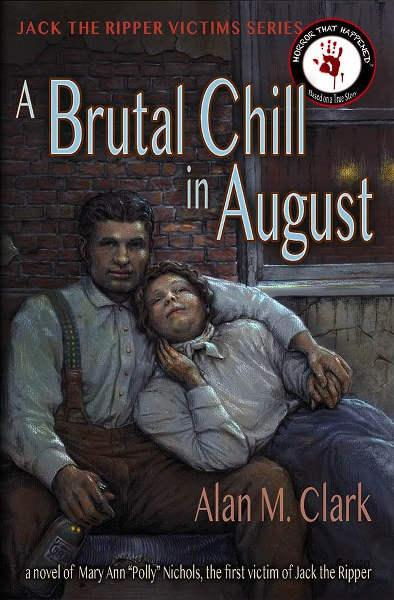
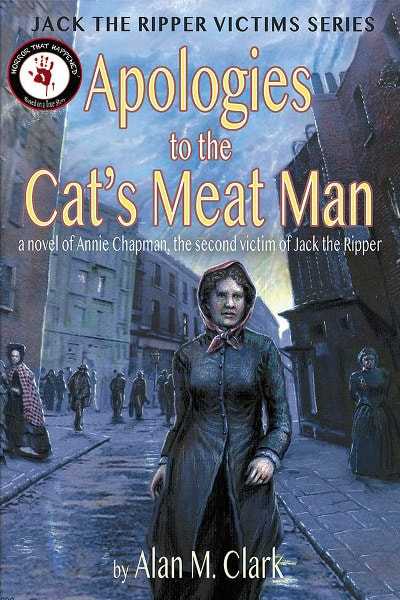
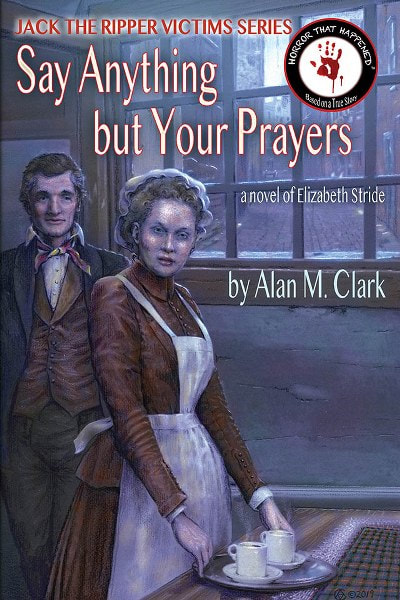
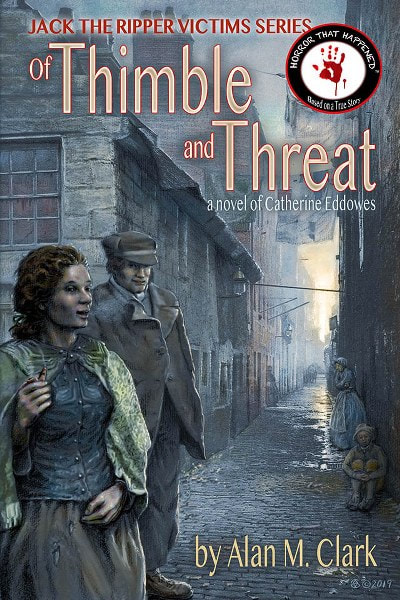
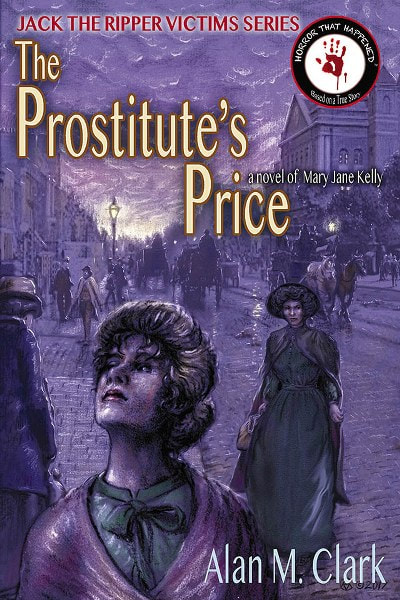




this cover is intriguing
As the author and illustrator of the Jack the Ripper Victims Series, I thank you for participating in the blog tour. I am happy to answer questions here or on Facebook: https://www.facebook.com/AlarmClank
sounds so good.
The covers are awesome! I am happy to participate in this giveaway.
I like the covers. They are very well done with great graphics. Apologies to the Cat’s Meat Man intrigues me the most.
The artwork on the covers is very interesting–especially the faces. You had me at “Jack the Ripper series”, lol. Thanks for the giveaway!
Sounds like a good book. I like the cover.
My daughter would enjoy these books
These books sound so good. The unsolved mystery of the Ripper is very intriguing.
I like the cover. It def draws me in. thank you
I really like how they are drawn or appear drawn.
i would love to read this. looks awesome. i love the cover.
The book covers are very vintage looking. I am not sure they are eye catching for myself at least but I understand the vintage look of the books.